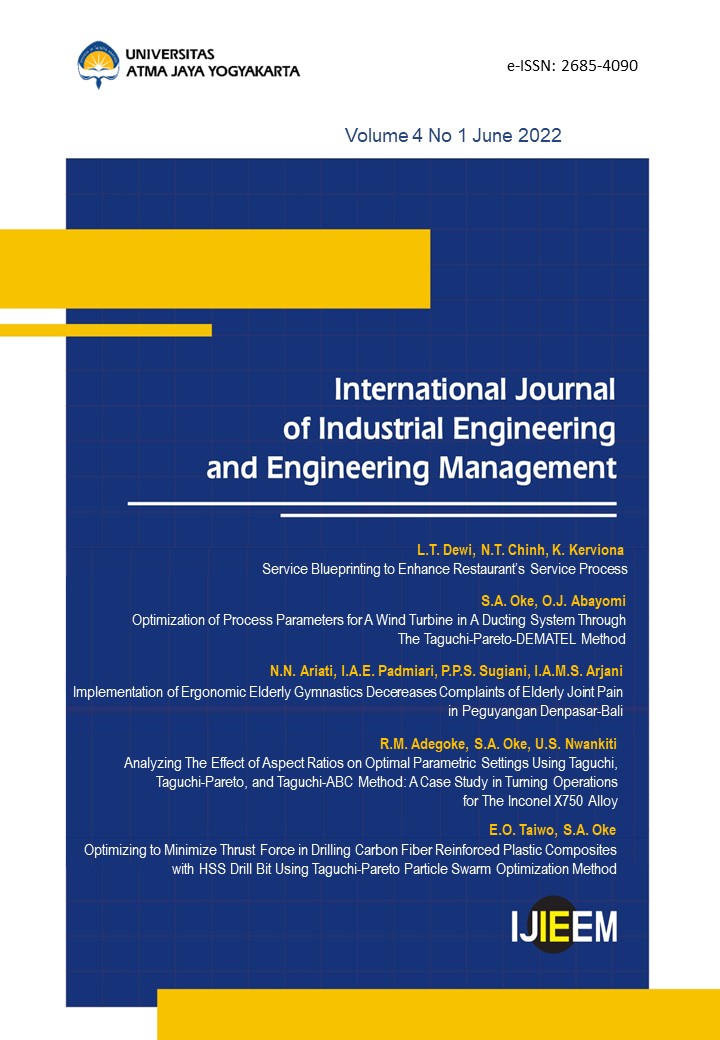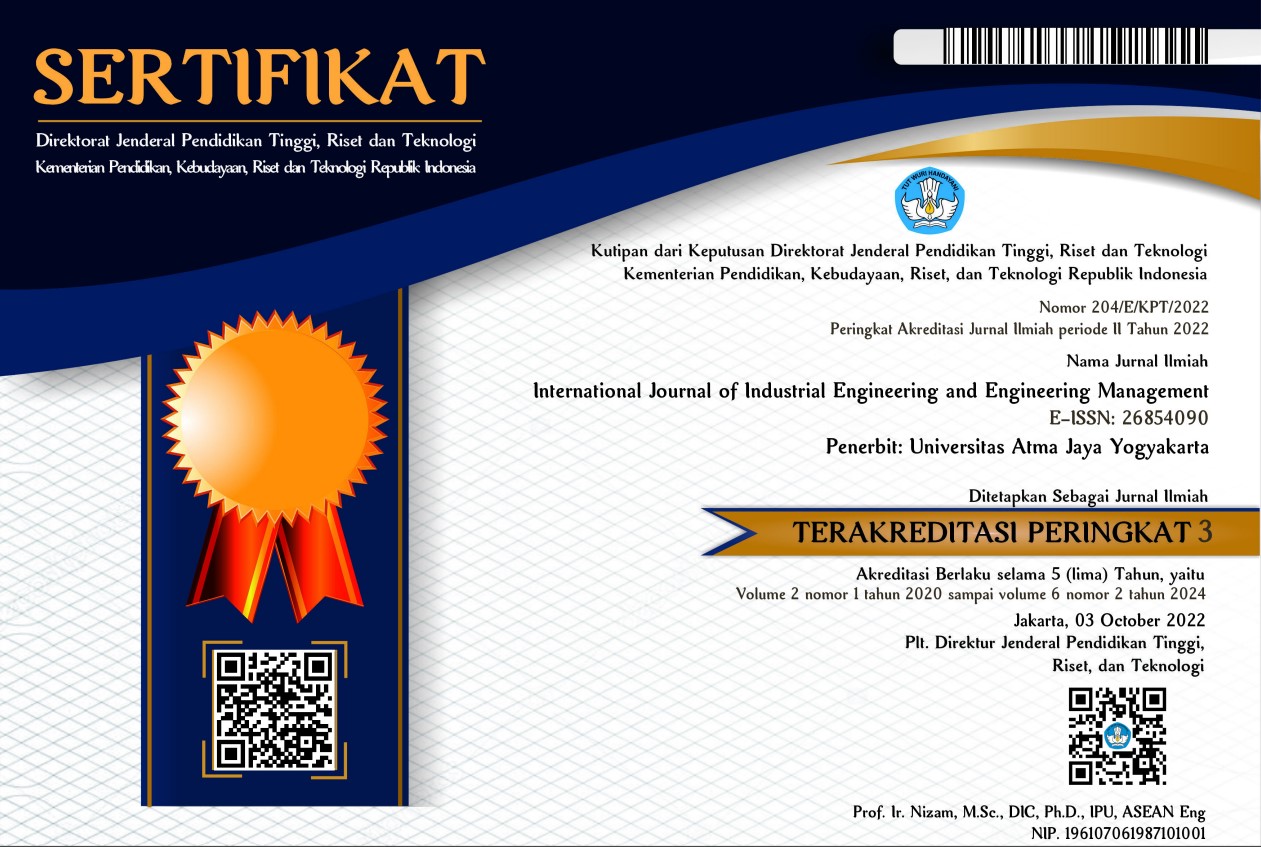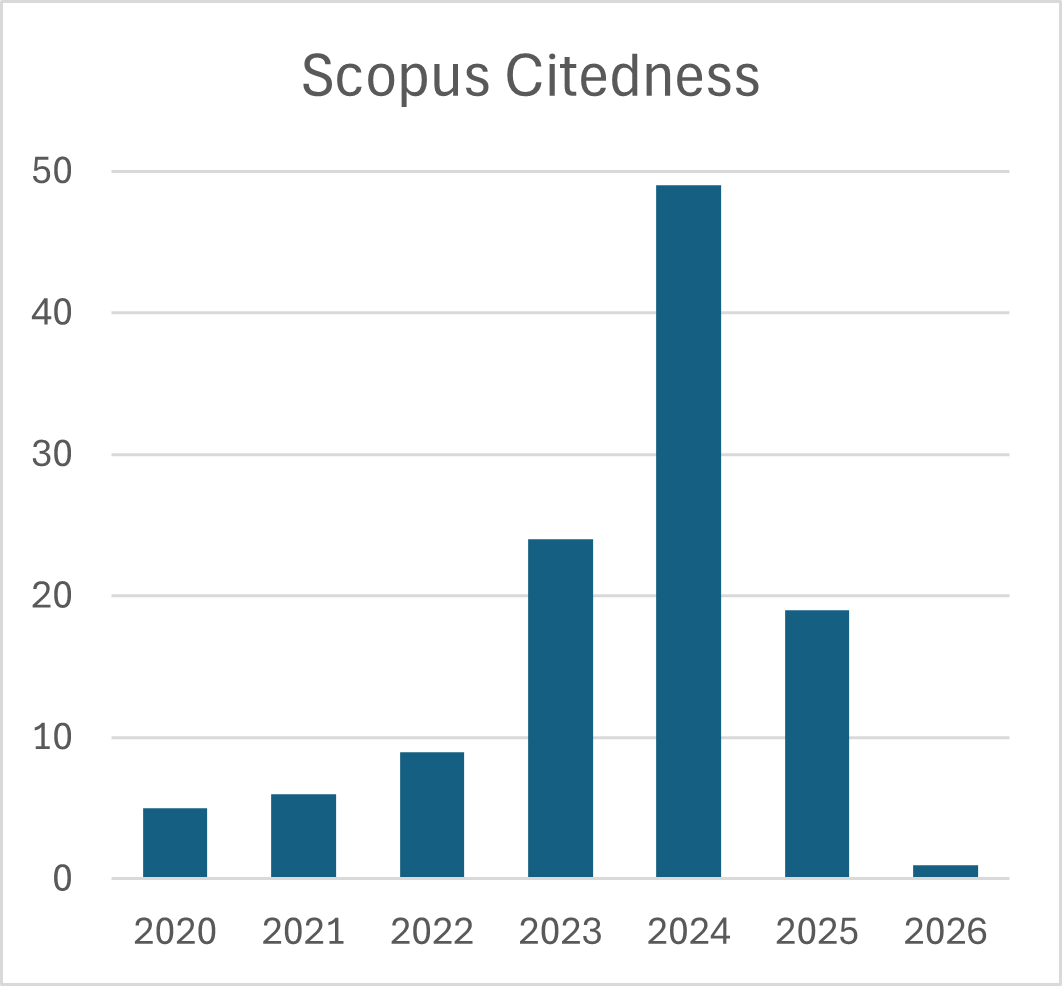Optimization of Process Parameters for A Wind Turbine in A Ducting System Through The Taguchi-Pareto-DEMATEL Method
DOI:
https://doi.org/10.24002/ijieem.v4i1.5531Keywords:
Wind turbine, ducting system, optimization, HVAC, DEMATEL, Taguchi methodAbstract
In a heating, ventilation, and air conditioning (HVAC) unit, ducting systems with wind turbines are responses to the
system’s high wind energy yields. However, the efficiency of the system is a challenge. To tackle this issue, optimization
of process parameters plays a central role. Unfortunately, while applying the Taguchi method as an optimization
procedure for high wind energy yields, the existing procedures are not clear enough to project a deep understanding of
how to establish priorities among the system's parameters and yet showcase relationships among them. Consequently,
this study proposes a new approach, the Taguchi-Pareto DEMATEL (Decision making trial and evaluation laboratory),
to establish priorities among the process parameters and concurrently define associations among the parameters of the
wind turbine inducting system. The proposed method amalgamates the Taguchi-Pareto method, which prioritizes the
process parameters and minimizes the anticipated value of the variance with DEMATEL. The DEMATEL method is
infused into the structure to verify interconnection among the wind turbine process parameters and establish a map to
show the comparative association within the parameters. Thus, the DEMATEL framework probes and solves the
complex energy yield problem of the wind turbine. The parameters used are input air pressure, ducting height, the
distance between the blower and the pipe, total effective length, and the gap between the truck and runout. The desired
optimal value of parameters for the proposed method are as follows: P2H2TG2EL1BD1, which is interpreted as 2.5m/s of
air pressure, 0.5in of height, 1in of truck gap, 0.5in of effective length, and 0.5in of blower distance. The optimized
parameters of a ducted wind turbine in an HVAC system could be of vast interest to HVAC systems to plan and monitor
wind turbine performance.
References
Abdelaziz, G., Abdel, H., Mohamed, A., Youssef, A., & Mohamed, H. (2022). Comparative investigation of the aerodynamic performance for several shrouded Archimedes spiral wind turbines. Energy, 239, Article122295
Abolfazl, M., & Aidin, G. (2021). Effect of boundary layer suction on performance of a 2 MW wind turbine. Energy, 232(4), Article121072.
Ajibade, O. A., Agunsoye, J. O., & Oke, S. A. (2021). Taguchi method and Taguchi-Pareto scheme to evaluate diffusivity during the development of orange peel epoxy composites. Journal of Applied Science & Process Engineering, 8(1), 765-785.
Akhilesh, A., & Neel, M. (2020). Design and development of small wind turbine for power generation through high velocity exhaust air. Renewable Energy, 145, 1487–1493.
Baratchi, F., Jeans. T., & Gerber, A. (2020). Assessment of blade element actuator disk method for simulations of ducted tidal turbines. Renewable Energy, 154, 290-304.
Claudio, A., Ivo, K., & Bert, B. (2021). Aerodynamic design optimization of ducted openings through high-rise buildings for wind energy harvesting. Building and Environment, 202, Article108028.
Fabio, N., Daniele, G., Davide, A., Fabio, B., & Livio, S. (2021). A new concept for a mini ducted wind turbine system. Renewable Energy, 175(18), 610-624.
Gandhi, S., Mangla, S. K., Kumar, P., & Kumar, D. (2015). Evaluating factors in implementation of successful green supply chain management using DEMATEL: A case study. International Strategic Management Review, 3(1–2), 96-109.
Hamid, A., Reza, K., & Manouchehr, R. (2016). Experimental investigation of blade number and design effects for a ducted wind turbine. Renewable Energy, 105, 334–343.
Harjeet, S., & Pradeep, K. (2020). Energy recovery ducted turbine system for chimney flue gas – a CFD based analysis to study the effect of number of blade and diffuser angle. Energy, 213(1), Article118501.
Hung, D., & Dirk, S. (2021). Wind turbine lifetime control using structural health monitoring and prognosis. IFAC-PapersOnline, 53, 12669-12674.
Islam, A., Saishuai, D., Sandy, D., Mohamed, E., Ahmed, B., Hosam, S., Selda, O., & Erkan, O. (2021). Experimental study on the motion response of an integrated floating desalination plant and offshore wind turbine on a non-ship platform. Ocean Engineering, 234(2), Article109275.
Jianjun, Y., Yanglin, C., Junlong, X., Xiaohong, H., Yuan, Z., Siyao, H., Shehab, S., & Jiejun, W. (2020). Effects of divergent angle on the flow behaviours in low speed wind accelerating ducts. Renewable Energy, 152, 1292–1301.
Liqun, M., Zichen, Z., Linyue, G., Yang, L., Hui, H. (2020). An exploratory study on using slippery liquid-infused-porous-surface (SLIPS) for wind turbine icing mitigation. Renewable Energy, 162, 2344–2360.
Maduekwe, V. C., & Oke, S. A. (2021). Novel Taguchi scheme-based DEMATEL methods and DEMATEL method for the principal performance indicators of maintenance in a food processing industry. International Journal of Intelligent Computing and Cybernetics, 14(3), 363-397.
Malik, A. A., Maharum, S. M., Tohid, M. Z. W. M., Ralimat, M. K., & Hamzah I. H. (2019). Statistical analysis using Taguchi method for wind turbine in ducting system. Indonesian Journal of Electrical Engineering and Computer Science, 15(1), 26-33.
Mauro, S., Brusca, S., Lanzafame, R., & Messina, M. (2019). CFD modeling of a ducted savonius wind turbine for the evaluation of the blockage effects on rotor performance. Renewable Energy, 141, 28–39.
Mousa, M., & Mojtaba, N. (2020). Feasibility study of new generation of wind (INVELOX), is it competitive with the conventional horizontal axis wind turbine? Energy, 217, Article119350.
Nemat, K., Barat, G., Gholamhasan, N., Abbas, R., Teymur, T., Esmail, M., Rizalman, M., Mohamed, M. (2021). Prediction of power generation and rotor angular speed of a small wind turbine equipped to a controllable duct using artificial neural. Renewable Energy, 196, 28–39.
Pre-Age, K., & Muyiwa, S. (2011). Performance and near wake measurements of a model horizontal axis wind turbine. Wind Energy, 15, 743-756.
Qazi, S., & Man-Hoe, K. (2021a). Power conversion performance of airborne wind turbine under unsteady loads. Renewable and Sustainable Energy Reviews, 153, Article111798.
Qazi, S., & Man-Hoe, K. (2021b). Design, and performance analysis of an airborne wind turbine for high-altitude energy harvesting. Energy, 230, Article120829.
Qun, C., Longfei, X., Zhengshun, C., & Mingyue, L. (2021). Dynamic responses of a 10 MW semi-submersible wind turbine at an intermediate water depth: A comprehensive numerical and experimental comparison. Ocean Engineering, 232, Article109138.
Rivarolo, M., Freda, A., & Traverso, A. (2020). Test campaign and application of a small ducted wind turbine with analysis of yaw angle influence. Applied Energy, 279(4), Article115850.
Rajendra, P., Manoj, K., Swaminathan, G., & Ganesh, B. (2020). Computational investigation and design optimization of a duct augmented wind turbine. Materials Today Proceedings, 22, 1186-1191.
Saleem, A., & Man-Hoe, K. (2019). Effect of rotor tip clearance on the aerodynamics performance of an aerofoil-based ducted wind turbine. Energy Conversion, and Management, 201, Article112186.
Sathish, T., Bala, S., Muthukumar, K., & Karthick, S. (2020). Design and simulation of wind turbine on rail coach on rail coach for power generation. Materialstoday: Proceedings, 33, 2535–2539.
Stefania, Z., & Stefano, L. (2019). Effects of upstream buildings on the performance of a synergistic roof-and-diffuser augmentation system for cross flow wind turbines. Journal of Wind Engineering and Industrial Aerodynamics, 184, 329–341.
Suthagar, S., Kumaran, T., Gowthan, T., Maridurai, T., Sathish, T., & Deivanayagi, S. (2021). Computational analysis of INVELOX wind turbine to analyse the venturi velocity by change the parameter of diffuser. Materialstoday: Proceedings, 46, 4245–4249.
Ssu-Yuan, H., & Jung-Ho, C. (2007). Innovatory designs for ducted wind turbines. Renewable Energy, 33, 1491–1498.
Saeed, Z., Siamak, A., & Manouchehr, R. (2015). RANS simulations of the stepped duct effect on the performance of a ducted wind turbine. Journal of Wind Engineering and Industrial Aerodynamics, 145, 270–279.
Tariq, A., & Markus, P. (2018). Analysis and optimization of ducted wind turbines. Energy, 162, 1234–1252.
Tarfaoui, M., Nachtane, M., Shah, O., & Boudounit, H. (2019). Numerical study of the structural static and fatigue strength of wind turbine blades. Materials Today: Proceedings, 12, 1215–1223.
Timothy, M., & Richard, E. (2009). Simulation of wind turbine wake interaction using vorticity transport model. Wind Energy, 13, 587-602.
Wai, H., & Fanzhong, M. (2021). Kalman-based interacting multiple-model wind speed estimator for wind turbines. IFAC-papersOnline, 53, 12644-12649.
Ziyun, W., Shiqian, W., Jiayou, R., Xi, M., & Yuling, W. (2020). Model experiment study for ventilation performance improvement of the wind energy fan system by optimizing wind turbines. Sustainable Cities and Society, 60(9), Article102212.
Downloads
Published
How to Cite
Issue
Section
License
Copyright (c) 2022 Sunday Ayoola Oke, Oluwatayo Johnson Abayomi

This work is licensed under a Creative Commons Attribution 4.0 International License.








